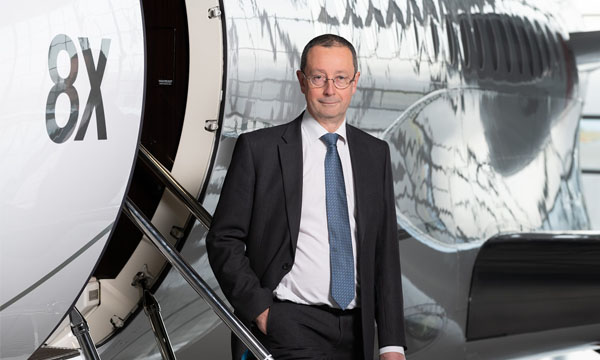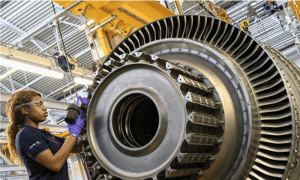 © Dassault Aviation
© Dassault Aviation
Jean Kayanakis (Dassault Aviation): "customer service quality is now clearly a critical argument"
Dassault Aviation has just announced the acquisition of RUAG Business Aviation's maintenance activities in Geneva and Lugano. This operation was not yet known when the Journal de l'Aviation met Jean Kayanakis, Senior Vice President, Worldwide Customer Service and Service Center Network. Nevertheless, he explained to us the strategy behind this new acquisition, following those of ExecuJet in January and TAG Maintenance Services in February. He also reviewed the new technological tools that Dassault Aviation is currently developing to improve its support offer.
At Ebace you presented the use of a drone for visual inspections around your aircraft, in partnership with the Donecle start-up. Since when have you put this in place?
For the moment, it is a military project, implemented on the Rafale in particular. As for civilian aircraft, we have been evaluating the solution for a few months now to see the defects on the fuselage, but also to characterise them thanks to artificial intelligence. We are not ready yet, but relatively interesting progress has been made. We are going to produce a proof of concept this year in the Falcon environment, in partnership with Dassault Falcon Service, our MRO subsidiary.
We think that the added value will come from major maintenance projects, replacing detailed visual inspection, or during pre-purchase inspection phases where you need to take a full look over the plane quickly.
While the drone is simple enough to implement, we can also imagine quasi-systematic use in the project start phase. When a plane has a defect, this would enable us to verify whether it is technically out of tolerance, and then identify it fully for the customer.
You also mentioned data analysis and predictive maintenance, which are appearing more and more as key MRO elements. How are you dealing with them and what objectives do you have?
It's a major objective for us, but we really need to position it in the specific context of business aviation. Operators generally don't have large fleets. Next, predictions are one thing, but we need to know what we do next and who decides. This means that our customers still make their own decisions, particularly on the removal of equipment.
Therefore, we are looking much more into troubleshooting. We realised that by analysing the fault message sequences recorded in the FHDB (Fault History DataBase, ed.) we could identify a certain number of fault signatures. And while we are able to do this after the fact, we can perhaps do it a little bit earlier, by noting in advance certain fault signatures that have already been identified.
We are also thinking about equipment reliability. We have a large quantity of data which we can use and break down more. This doesn't tell us everything, but we still have a lot of elements to identify recurring faults and strengthen monitoring on certain equipment.
The ultimate objective is to avoid a fault which grounds the plane, but we can also have real added value by targeting the faults more. For example, this lets us be sure that our assistance aircraft, FalconResponse, takes off with the right part and the right tools.
These are areas for progress on which we are working actively.
Are you going to pass a milestone with the new generations of Falcon?
We are currently working on the Falcon 7X and 8X, but we are starting to look at the 6X, whose entry into service is scheduled for 2022. We are very ambitious with this programme in terms of studies on system convergence, recording levels, how we process data and so on.
The volume of data should also increase significantly. We need to take care that we get the relevant data and make sure we don't take too much either. The more things we record the harder it will be to process them within a limited time frame.
Are you already working with your network on this approach?
For the moment we are defining what will come on top of the fault analysis defined in the documentation. This is the heart of the technical support and fault analysis business. What's certain is that Dassault Falcon Service or Dassault Falcon Jet in the United States are used to dealing with a certain number of things, but we are defining the heart of the support teams system by system.

© Dassault Aviation
As for TAG Maintenance Services and ExecuJet, why did Dassault Aviation decide to purchase these two entities?
The strategy is for the aircraft manufacturer to be more involved in the MRO activity to manage its customer experience better and leave it up to third parties less. Competition between aircraft manufacturers is getting tougher and tougher and is being played out more and more in technical support, spares and now in maintenance.
It is a worldwide issue, with two axes. There is the Asia-Pacific region, where the Falcon fleet has been growing constantly for the last ten years and where we want to strengthen our presence. It was ExecuJet's footprint in the zone, in Malaysia or in Australia, which really encouraged us to acquire the company, over and beyond their very interesting presence in the Middle East and in Africa.
With TAG Maintenance Services, we wanted to control our capacities in Europe better. We have major capacity with Dassault Falcon Service, but there is a significant part which was getting away from us. We don't want to be exclusive, but if we want to be in control of our own destiny in the medium terms we needed to strengthen our capacities.
Will there be Falcon dedicated areas in the TAG Maintenance Services and ExecuJet centres?
We are pragmatic about it. One of our main axes is to develop Malaysia with Execujet. They hadn't been taking care of Falcons and now they are already starting to do so. We are currently qualifying people on site and we have already repaired one plane with their help.
Of course, we are going to be developing or strengthening Falcon activities, but this will not be exclusive and we will be continuing our multi-brand activity.
Do you want to continue to grow this network and create a real services division?
As Eric Trappier said, we are permanently evaluating the market opportunities. The objective isn't to capture 90% of capacity or to target an improvement in profitability. Our objective is to secure the Falcon maintenance share and to coordinate our different entities to improve service. Customer service quality is now clearly a critical argument in selling planes, which remains our main business.
The organisation has also evolved, with the grouping together of MRO and technical and operational support. Here we find everything to do with customer relations after the plane is delivered. This is what we call the customer experience.












